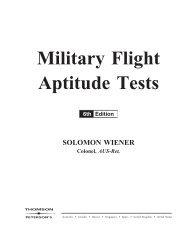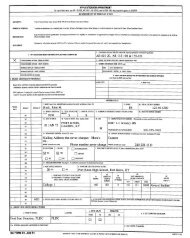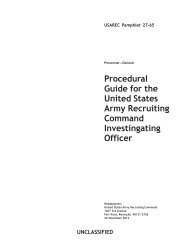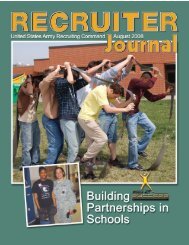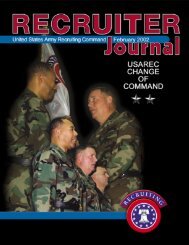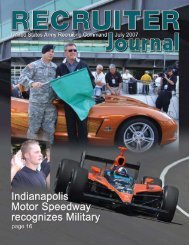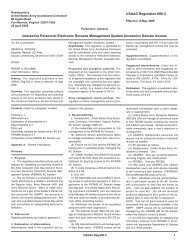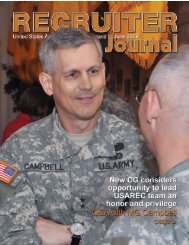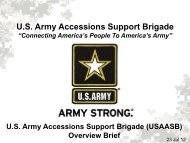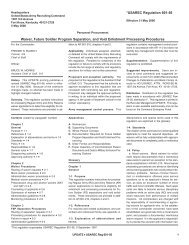Military Flight Aptitude Tests - USAREC - U.S. Army
Military Flight Aptitude Tests - USAREC - U.S. Army
Military Flight Aptitude Tests - USAREC - U.S. Army
Create successful ePaper yourself
Turn your PDF publications into a flip-book with our unique Google optimized e-Paper software.
26 Part I: Careers in <strong>Military</strong> Aviation<br />
pedals, landing gear handle, fuel gauge, and other<br />
instruments vital to an aircraft in flight.<br />
The student pilots then take to the air in the T-34C<br />
Mentor, an aerobatic turboprop. After 13 flights with their<br />
instructors and many hours of briefings, they are ready to<br />
fly solo. They complete a total of 41 flights (4 solo) in<br />
primary training.<br />
During training, students study meteorology, aerodynamics,<br />
aircraft engines, instruments and navigation, and<br />
take other related flight courses<br />
Upon completion of primary flight training, the<br />
student aviators are channeled into the jet, multiengine, or<br />
helicopter pipeline. The selection is based upon the<br />
student’s preference and grades, as well as the needs of the<br />
service.<br />
Intermediate and Advanced Training<br />
Following primary training, and depending upon preference,<br />
overall class rank, grade average in training, and the<br />
needs of the Marine Corps, students are assigned to one of<br />
three training pipelines. These are<br />
n Jet (Strike)<br />
n Multiengine (Prop)<br />
n Helicopter (Rotary)<br />
1. Intermediate and Advanced Jets (Strike)<br />
Student jet pilots take intermediate training for twenty-two<br />
weeks in a T-2C Buckeye jet trainer at either NAS,<br />
Meridian, Mississippi, or NAS, Kingsville, Texas. They<br />
concentrate on formation flying, air-to-air gunnery, and<br />
more instrument work. They also make about a half-dozen<br />
carrier arrested landings aboard a fleet aircraft carrier.<br />
During advanced training at the same location,<br />
students fly a TA-4J Skyhawk, a two-seat, light attack<br />
trainer. They learn strike tactics, weapons delivery, and air<br />
combat maneuvering. In addition, they make several<br />
arrested landings.<br />
Strike training, from the start of Aviation Preflight<br />
Indoctrination until students earn their wings, lasts about<br />
seventy-five weeks and includes about 260 hours of flight<br />
training and 140 hours of simulator training.<br />
2. Intermediate and Advanced Maritime<br />
Student maritime (multiengine) pilots take five weeks of<br />
intermediate training in a T-34C Mentor turboprop trainer<br />
at NAS, Whiting Field, Milton, Florida, or NAS, Corpus<br />
Christi, Texas. Advanced maritime training takes place at<br />
NAS, Corpus Christi, Texas. During advanced training,<br />
maritime students use the T-44 Pegasus (King Air) aircraft<br />
and concentrate on improving more complicated flying<br />
skills, such as instrument capability and single-engine<br />
approaches in simulated weather conditions, and perform<br />
many mock missions with training aircraft.<br />
www.petersons.com/arco<br />
Maritime training, from the start of Aviation Preflight<br />
Indoctrination until students earn their wings, lasts<br />
fifty-four weeks and includes about 180 hours of flight<br />
training and 67 hours of simulator training.<br />
3. Intermediate and Advanced Helicopter<br />
Student helicopter pilots take five weeks of intermediate<br />
training in a T-34C Mentor turboprop trainer at NAS<br />
Whiting Field, Milton, Florida, or NAS, Corpus Christi,<br />
Texas. The emphasis is on additional instrument navigation.<br />
Advanced helicopter training takes place at NAS,<br />
Whiting Field, Milton, Florida, for about twenty-one<br />
weeks. During advanced training, students use the TH-57<br />
Sea Ranger; advanced training includes learning the unique<br />
characteristics of rotary-winged aviation, more instruments,<br />
reading charts, low-level contour flying, formations,<br />
tactical approaches, external loads, and confined-area<br />
landings.<br />
Helicopter training, from the start of Aviation<br />
Preflight Training until students earn their wings, lasts<br />
about fifty-five weeks and includes about 208 hours of<br />
flight training and 80 hours of simulator training.<br />
Designation<br />
Upon successful completion of advanced training, students<br />
are designated naval aviators and earn their wings of gold.<br />
They are now ready for squadron training and assignment.<br />
Squadron Assignment and Training<br />
Upon completion of flight training, officers can expect<br />
assignment to either the 2nd or 3rd Marine Aircraft Wing.<br />
There are also a limited number of billets available with the<br />
1st Marine Brigade in Hawaii. Newly designated Naval<br />
Aviators are not normally assigned directly to the 1st<br />
Marine Aircraft Wing.<br />
Officers reporting to a squadron from the training<br />
command will usually be placed in the type aircraft in<br />
which they qualified during advanced training. Their MOS<br />
will be those of basic pilots for fixed wing or for<br />
helicopters. Upon completion of a squadron training<br />
syllabus, they will be recommended for an MOS<br />
compatible with the type aircraft they are flying.<br />
A training flow chart for Marine Naval Aviators for<br />
jets, multiengine props, and helicopters is shown on page 27.<br />
Photos of some of the Marine Corps aircraft are<br />
shown on pages 29 and 30.<br />
<strong>Flight</strong> Officer Training<br />
Preliminary Training<br />
Marine student naval flight officers report directly from the<br />
Basic School to Naval Air Station, Pensacola, Florida.<br />
They check in with the marine Aviation Training Support



